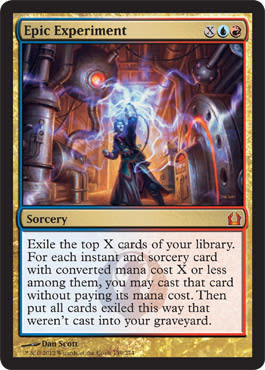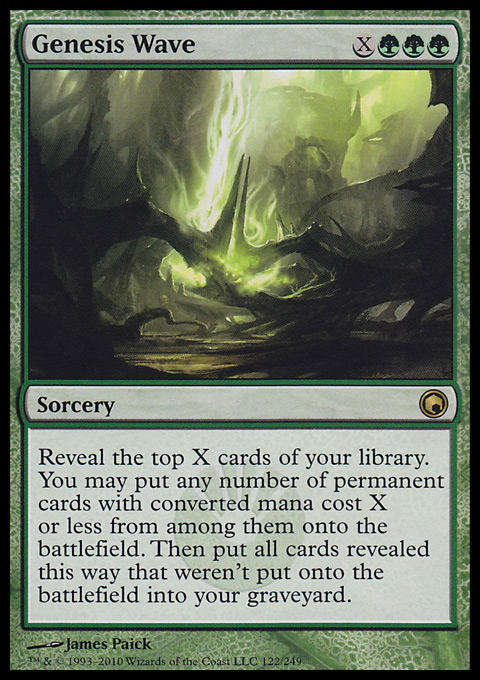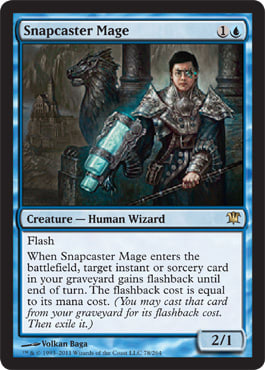For a lot of people, the obvious jump from Epic Experiment is to burn spells, and when looking through people’s brews, I saw a lot of Searing Spears and Thunderous Wraths. In the previous Standard, there was a fringe combo deck using cards such as Mycosynth Wellspring, Krenko's Command, Kuldotha Rebirth, and Burn at the Stake. So with the new Standard, another option was to play a bunch of tokens and Epic Experiment into Burn at the Stake.
This idea appealed to me as well, but one thing was somewhat disheartening: If you reveal token spells and Burn at the Stake off an Epic Experiment, the tokens created by those spells don’t arrive in time to be tapped for the additional cost of the Burn at the Stake. You have to pay the cost of Burn at the Stake before the token spells resolve, so basically, the only tokens you can tap for your big burn spell are the ones you already had on the battlefield before casting your Epic Experiment.
That’s not so bad—treating Epic Experiment as a Stroke of Genius that also casts for free the spells it draws works just fine in that kind of deck. In fact, I even played against such a deck (and lost to it) in the FNM. Intangible Virtue plays as a great second win condition next to Burn at the Stake in a tokens deck.
But as for me, I had a different line of thinking.
The Logical Steps
Here’s how my thought process went when starting to brew with the epic Izzet spell.
- This spell is a lot like Genesis Wave, but it’s for instants and sorceries. Decks are full of lands, though, and Genesis Wave benefits from that fact while Epic Experiment suffers.
- Like Genesis Wave, Epic Experiment desires much mana to create a huge effect.
- To address both of the first two points, Farseek and Ranger's Path can be played. These are sorceries, so they can be cast by eventual Experiments, but they can also be cast earlier in the game both to accelerate into larger Experiments and to reduce the number of land cards remaining in the deck, thus creating more powerful Experiments.
- The final key is finding a win condition, and the innocuous common Dreadwaters from Avacyn Restored plays very well along all the axes set out by the points above. It’s a sorcery, and it, like Epic Experiment, appreciates a high land count.
From there, the addition of Boundless Realms, Temporal Mastery, and Snapcaster Mage put the deck into over-the-top mode. I expected my deck to accelerate into a large Experiment fairly quickly, but not so quickly that a few Fogs wouldn’t be useful in buying extra turns against very aggressive decks.
Noting the six 7-mana spells (two Boundless Realms and four Temporal Mastery), I settled on an Epic Experiment for 7 as the baseline for the spell. Casting it with X equal to 6 would feel really awful if I missed on a Temporal Mastery or a Boundless Realms, and the combined impact of a mix of most of the other spells in the deck would just not be worth the 8 mana. Note that in a pinch, the deck would sometimes want to Experiment for all but ![]() , leaving mana up for any hypothetical Fogs drawn by any hypothetical Divinations.
, leaving mana up for any hypothetical Fogs drawn by any hypothetical Divinations.
Less than an hour before the tournament, I was convinced to add a splash of white for Terminus to give the deck a little more time. You’ll notice a few three-ofs that used to be four-ofs before the white addition. Here’s the deck I managed to take to a commanding 2–3 record:
"The Dreadwater Experiment"
- Creatures (4)
- 4 Snapcaster Mage
- Spells (34)
- 1 Psychic Spiral
- 3 Fog
- 2 Boundless Realms
- 2 Devastation Tide
- 3 Divination
- 3 Dreadwaters
- 3 Terminus
- 4 Epic Experiment
- 4 Farseek
- 4 Ranger's Path
- 4 Temporal Mastery
- 1 Cyclonic Rift
- Lands (22)
- 11 Forest
- 2 Mountain
- 3 Island
- 1 Hallowed Fountain
- 1 Temple Garden
- 4 Steam Vents
- Sideboard (15)
- 1 Terminus
- 3 Syncopate
- 3 Counterlash
- 3 Goblin Electromancer
- 3 Crippling Chill
- 1 Divination
- 1 Fog
The Good
The deck was pretty fun to play, and it also made me quite famous around the room. “You’re the guy playing Dreadwaters? Awesome.”
Surviving an attack at 1 life with no cards in hand, drawing a Snapcaster Mage with nineteen lands on the battlefield, and flashing back an Epic Experiment for 15 into multiple copies of Temporal Mastery and Dreadwaters—all after time has been called in the round—to win the game was pretty much the highlight of the night.
The core cards of the deck—Farseek, Ranger's Path, Dreadwaters, Boundless Realms, Snapcaster Mage, Temporal Mastery, and Divination—all performed very well. I was hoping to have two copies of Cyclonic Rift, but I could only get my hands on one. This card was also great. While 7 mana is a lot, and the overload ability doesn’t play well with Snapcaster Mage or Epic Experiment, having the option to just delay a single threat for 2 mana was very useful.
The Bad
I wouldn’t say Terminus was bad, but 6 mana was a lot when I really wanted to be finding more lands, drawing more cards, or just casting an Epic Experiment. Supreme Verdict was recommended, and if I can pick up some copies of that before I play the deck next, I’m pretty sure that’s what I’ll do. Note that Terminus would have been better if I had two Temple Gardens in the deck. Unfortunately, I only had one, and every time I cast Ranger's Path for one Temple Garden and one Forest, a little part of me died—especially if I was holding a
Fog didn’t really do the work I was expecting it to do. Actually, I guess the rest of the deck didn’t do what I expected it to. If I’d had Farseeks and Ranger's Paths all the time and I’d always been able to cast an Experiment for 7 around turn six, the 1-mana Fogs would have been great. However, combo decks don’t always draw their cards in the right order, and this one was no exception. Sometimes, I just didn’t have the right spells to cast with the amount of mana I had—or didn’t have—available, and Fog’s temporary buying of time didn’t turn out to actually be what the deck needed.
Similarly, Devastation Tide turned out to be more temporary than I’d hoped. Spending 5 mana is a sizable amount, and I was never able to bounce my own Snapcaster Mage for value as I’d planned during deck-building. I thought this might be the right deck for Devastation Tide, but without the 2-mana option of Cyclonic Rift, this blue miracle just didn’t get the job done. Then again, I didn’t see many copies of this during my five rounds, so it’s possible it just didn’t get a fair shake.
Psychic Spiral was a fine mill spell, but it wasn’t super-effective, and I don’t think its capacity to restock my library was ultimately necessary.
The R/U/Gly
A few changes I’d make going forward would be cleaning up the mana and just fixing the numbers. Finding room for Terminus at the last minute made things a little rough, but after playing a few matches, I think I have a little more information to go on.
One misconception I had about the deck was thinking it wouldn’t need to run as many lands because of all the Farseeks and Ranger's Paths. However, the deck really wants to make its land drops in addition to casting those spells. If you’re casting Farseek but not playing a land for the turn, you’re really just playing a really expensive land. (More expensive than a Transguild Promenade!)
And on the topic of mana acceleration, I just want more. Obviously, something such as Cultivate would be amazing, but I was racking my brain to think of creative solutions for the deck’s desperate need for a fifth through eighth Farseek. The answer came while watching Pro Tour: Return to Ravnica coverage this weekend as Jon Finkel played Goblin Electromancer in his U/R Pyromancer Ascension storm deck. He paid 2 for the Goblin and proceeded to net about 5 mana with the creature over the course of the turn.
Now, this deck doesn’t cast too many spells in a single turn (unless they’re free), so the ![]()
![]() creature is unlikely to generate that kind of advantage, but the difference between being able to cast both a Ranger's Path and a Divination in a single turn and having to choose between them is pretty huge. There’s the downside that it’s a creature instead of a sorcery, but that means it can chump-block, and a random extra Farseek while Experimenting doesn’t actually make a big difference anyway.
creature is unlikely to generate that kind of advantage, but the difference between being able to cast both a Ranger's Path and a Divination in a single turn and having to choose between them is pretty huge. There’s the downside that it’s a creature instead of a sorcery, but that means it can chump-block, and a random extra Farseek while Experimenting doesn’t actually make a big difference anyway.
Before Terminus, a previous iteration of the deck didn’t even have Devastation Tide or Cyclonic Rift. In those three slots were one Past in Flames and two Mystic Retrieval. A few times during the tournament, I found myself with a ton of mana and no cards in hand, hoping for a redeeming top-deck. Finding room again for even one copy of one of those cards could make the difference.
Finally, one sneaky sideboard card I feel is worth mentioning, and that’s Counterlash. While I don’t play a ton of Standard, I once penciled a decklist that had a side goal of casting a Counterlash to counter a Ponder and drop an Army of the Damned. While countering a Ponder is no longer an option and you can’t expect every opponent to be playing sorceries nowadays, it’s still a real dream. While this deck won’t be summoning thirteen Zombies, against an opposing Epic Experiment deck (and/or a Burn at the Stake deck), it can be quite handy, countering the opponent’s key spell and allowing you to drop an otherwise-hard-to-cast Boundless Realms or Temporal Mastery. However, Counterlash has an additional benefit in an Epic Experiment deck. If you Experiment into the Dark Ascension junk rare, you can cast your spells in such an order that Counterlash counters a useless Farseek or the like, allowing you to make use of a 7-mana spell that had been stuck in your hand.
Epic . . . Success?
After recalibrating and taking new measurements, let’s try this experiment again. Here’s what I plan to play when I get another chance to try this deck.
"The Dreadwater Experiment"
- Creatures (5)
- 3 Snapcaster Mage
- 2 Goblin Electromancer
- Spells (31)
- 1 Past in Flames
- 2 Boundless Realms
- 3 Supreme Verdict
- 3 Divination
- 3 Dreadwaters
- 4 Epic Experiment
- 4 Farseek
- 4 Ranger's Path
- 4 Temporal Mastery
- 1 Thoughtflare
- 2 Cyclonic Rift
- Lands (24)
- 11 Forest
- 3 Mountain
- 3 Island
- 1 Hallowed Fountain
- 2 Temple Garden
- 4 Steam Vents
- Sideboard (15)
- 1 Sphinx's Revelation
- 1 Supreme Verdict
- 2 Cyclonic Rift
- 3 Syncopate
- 3 Counterlash
- 2 Goblin Electromancer
- 3 Crippling Chill
That list still might not win you many packs in an FNM, but if you’re just looking for a fun deck, you like a challenge, or you want to become “The Dreadwaters Guy,” give The Dreadwater Experiment a shot. Until next time, I’m Andrew saying, “Beware experimental waters.”
Andrew Wilson
fissionessence at hotmail dot com



























